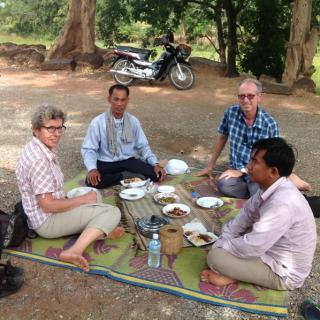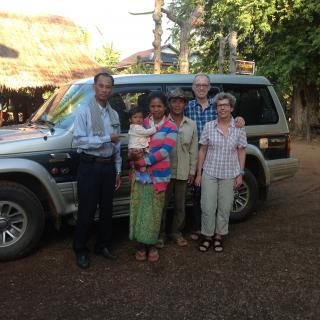


.jpg)









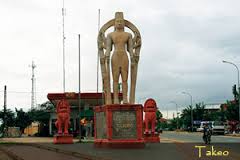 Takeo province is often referred to as the cradle of Cambodian civilisation Takeo province has several important pre-Angkorian sites built between the 5th and the 8th century. The provincial capital, Takeo town is an easygoing place that possesses a fair amount of natural and manmade beauty. The natural beauty is in the Scenic River and lake area that faces a pleasant town parkway. The low-lying area seems to include much of the surrounding province area, which is probably why a kingdom that once had its heart here was referred to as Water Chenla. There seems to be water everywhere in the surrounding countryside during the rainy season. The man-made beauty mostly comes from a series of canals and waterways that were cut through the surrounding countryside, many a very long time ago, connecting towns, villages, rivers and Vietnam. Nearby Angkor Borei town (connected by water to Takeo town) may have been the heart of the Funan Empire, which is called the Cradle of Khmer Civilization by Cambodians. Much older than Angkor, the Funan empire had its heyday between the 1st and 6th centuries and stretched across a vast area, from South Vietnam through Thailand, down through Malaysia and into Indonesia. Bold, silver and silks were traded in abundance in the kingdom, or, as some say, the series of fiefdoms.
Takeo province is often referred to as the cradle of Cambodian civilisation Takeo province has several important pre-Angkorian sites built between the 5th and the 8th century. The provincial capital, Takeo town is an easygoing place that possesses a fair amount of natural and manmade beauty. The natural beauty is in the Scenic River and lake area that faces a pleasant town parkway. The low-lying area seems to include much of the surrounding province area, which is probably why a kingdom that once had its heart here was referred to as Water Chenla. There seems to be water everywhere in the surrounding countryside during the rainy season. The man-made beauty mostly comes from a series of canals and waterways that were cut through the surrounding countryside, many a very long time ago, connecting towns, villages, rivers and Vietnam. Nearby Angkor Borei town (connected by water to Takeo town) may have been the heart of the Funan Empire, which is called the Cradle of Khmer Civilization by Cambodians. Much older than Angkor, the Funan empire had its heyday between the 1st and 6th centuries and stretched across a vast area, from South Vietnam through Thailand, down through Malaysia and into Indonesia. Bold, silver and silks were traded in abundance in the kingdom, or, as some say, the series of fiefdoms.
Although Cambodians claim Funan was created by Khmers, neighbouring Vietnam argues that they were the people of origin. Archaeologists from the University of Hawaii of the USA have made research trips to Angkor Borei in an attempt to piece together the history and story, and story, as well as relics, of the Funan period. In an odd recent twist, Reuters News Service reported in early November 1999 that locals saw the research team digging up ancient relics and figured the stuff must be valuable, so they started digging and looting objects from the area. Fortunately, the Cambodian government seems to be moving in on the problem quickly to try to save what they can of this important piece of Khmer heritage.
That was not the first time the locals have created problems in the piecing together of ancient history. Much of what did remain in the form of ancient ruins in Angkor Borei was destroyed not too long ago in the modern past. The officials that runs the museum that's dedicated to the history of the Funan empire told me that much of what was still standing from this period (from parts of ancient walls to partial structures) was thought to be useless by locals and was bulldozed and razed to make way for more useful modern day structures! Talk about having a bad track record. Fortunately artifacts and history have been put together in the museum.
Takeo Province is full of other interesting sights as well and because of the short distance and good road from Phnom Penh, all are great day trips. Some sights can be combined in a day trip. If you have a bit more time, spend an evening in Takeo town and take in all the sights. There is a pleasant little place to stay overlooking the river and lake area.
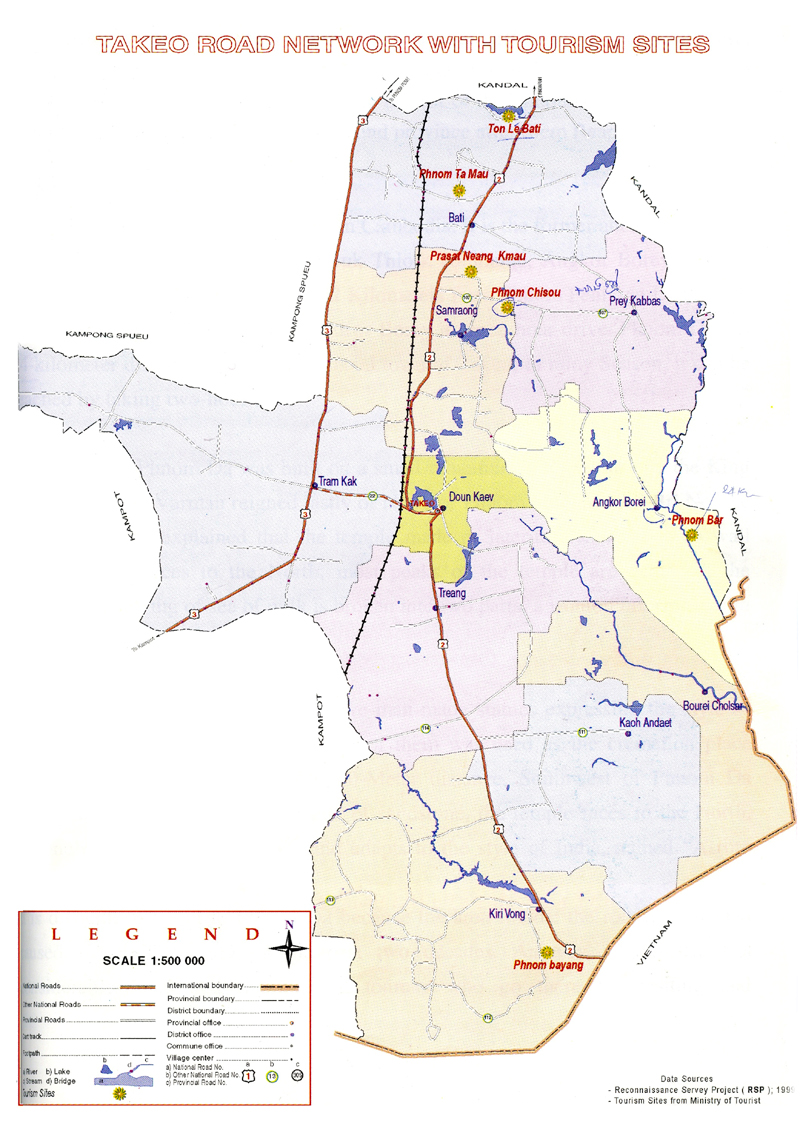 Takeo province is 3,563 square kilometres big. It's located in the South of the country bordering to the North and East with Kandal, to the West with Kampong Speu and Kampot and to the South with Vietnam. The low-lying area seems to include much of the surrounding province area, which is probably why a kingdom that once had its heart here was referred to as Water Chenla. There seems to be water everywhere in the surrounding countryside during the rainy season.
Takeo province is 3,563 square kilometres big. It's located in the South of the country bordering to the North and East with Kandal, to the West with Kampong Speu and Kampot and to the South with Vietnam. The low-lying area seems to include much of the surrounding province area, which is probably why a kingdom that once had its heart here was referred to as Water Chenla. There seems to be water everywhere in the surrounding countryside during the rainy season.
Therefore the province consists of the typical plain wet area for Cambodia, covering rice fields and other agricultural plantations. The province also features one of the biggest rivers of the country (symbolizing the provincial border to the East), the Tonle Bassac (also known as the ?Red River?).
The country has a tropical climate - warm and humid. In the monsoon season, abundant rain allows for the cultivation of a wide variety of crops. This year-round tropical climate makes Cambodia ideal for developing tourism. Travellers need not to fear natural disasters such as erupting volcanoes or earthquakes, and the country is not directly affected by tropical storms.
Climate: Cambodia can be visited throughout the year. However, those plans to travel extensively by road should be avoided the last two months of the rainy season when some countryside roads may be impassable. The average temperature is about 27 degrees Celsius; the minimum temperature is about 16 degrees. December and January are the coolest months, whereas the hottest is April.
General information about the provincial climate:- Cool season: November- March (22-28c)
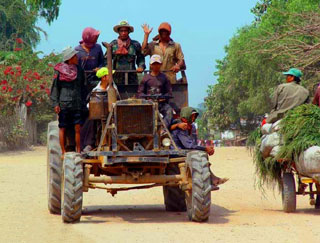 Takeo province is often referred to as the cradle of Cambodian civilisation Takeo province has several important pre-Angkorian sites built between the 5th and the 8th century. The provincial capital, Takeo town is an easygoing place that possesses a fair amount of natural and manmade beauty. The natural beauty is in the Scenic River and lake area that faces a pleasant town parkway. The low-lying area seems to include much of the surrounding province area, which is probably why a kingdom that once had its heart here was referred to as Water Chenla. There seems to be water everywhere in the surrounding countryside during the rainy season. The man-made beauty mostly comes from a series of canals and waterways that were cut through the surrounding countryside, many a very long time ago, connecting towns, villages, rivers and Vietnam. Nearby Angkor Borei town (connected by water to Takeo town) may have been the heart of the Funan Empire, which is called the Cradle of Khmer Civilization by Cambodians. Much older than Angkor, the Funan empire had its heyday between the 1st and 6th centuries and stretched across a vast area, from South Vietnam through Thailand, down through Malaysia and into Indonesia. Bold, silver and silks were traded in abundance in the kingdom, or, as some say, the series of fiefdoms.
Takeo province is often referred to as the cradle of Cambodian civilisation Takeo province has several important pre-Angkorian sites built between the 5th and the 8th century. The provincial capital, Takeo town is an easygoing place that possesses a fair amount of natural and manmade beauty. The natural beauty is in the Scenic River and lake area that faces a pleasant town parkway. The low-lying area seems to include much of the surrounding province area, which is probably why a kingdom that once had its heart here was referred to as Water Chenla. There seems to be water everywhere in the surrounding countryside during the rainy season. The man-made beauty mostly comes from a series of canals and waterways that were cut through the surrounding countryside, many a very long time ago, connecting towns, villages, rivers and Vietnam. Nearby Angkor Borei town (connected by water to Takeo town) may have been the heart of the Funan Empire, which is called the Cradle of Khmer Civilization by Cambodians. Much older than Angkor, the Funan empire had its heyday between the 1st and 6th centuries and stretched across a vast area, from South Vietnam through Thailand, down through Malaysia and into Indonesia. Bold, silver and silks were traded in abundance in the kingdom, or, as some say, the series of fiefdoms.
The current population in this province is about 924,758 people or 6.4% of the country's total population (14,363,519 person in Cambodia, 2007, provincial government data), with 445,000 male and 479,758 female. The population density is therefore 259.5 people per square kilometre.
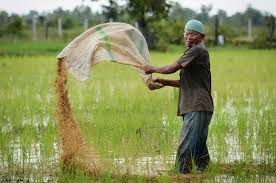 Takeo province is often referred to as the cradle of Cambodian civilisation Takeo province has several important pre-Angkorian sites built between the 5th and the 8th century. The provincial capital, Takeo town is an easygoing place that possesses a fair amount of natural and manmade beauty. The natural beauty is in the Scenic River and lake area that faces a pleasant town parkway. The low-lying area seems to include much of the surrounding province area, which is probably why a kingdom that once had its heart here was referred to as Water Chenla. There seems to be water everywhere in the surrounding countryside during the rainy season. The man-made beauty mostly comes from a series of canals and waterways that were cut through the surrounding countryside, many a very long time ago, connecting towns, villages, rivers and Vietnam. Nearby Angkor Borei town (connected by water to Takeo town) may have been the heart of the Funan Empire, which is called the Cradle of Khmer Civilization by Cambodians. Much older than Angkor, the Funan empire had its heyday between the 1st and 6th centuries and stretched across a vast area, from South Vietnam through Thailand, down through Malaysia and into Indonesia. Bold, silver and silks were traded in abundance in the kingdom, or, as some say, the series of fiefdoms.
Takeo province is often referred to as the cradle of Cambodian civilisation Takeo province has several important pre-Angkorian sites built between the 5th and the 8th century. The provincial capital, Takeo town is an easygoing place that possesses a fair amount of natural and manmade beauty. The natural beauty is in the Scenic River and lake area that faces a pleasant town parkway. The low-lying area seems to include much of the surrounding province area, which is probably why a kingdom that once had its heart here was referred to as Water Chenla. There seems to be water everywhere in the surrounding countryside during the rainy season. The man-made beauty mostly comes from a series of canals and waterways that were cut through the surrounding countryside, many a very long time ago, connecting towns, villages, rivers and Vietnam. Nearby Angkor Borei town (connected by water to Takeo town) may have been the heart of the Funan Empire, which is called the Cradle of Khmer Civilization by Cambodians. Much older than Angkor, the Funan empire had its heyday between the 1st and 6th centuries and stretched across a vast area, from South Vietnam through Thailand, down through Malaysia and into Indonesia. Bold, silver and silks were traded in abundance in the kingdom, or, as some say, the series of fiefdoms.
Takeo's economy consists basically of agricultural farming, fishery, rice and fruit cropping. Especially the rural households depend on agriculture and its related sub-sectors.
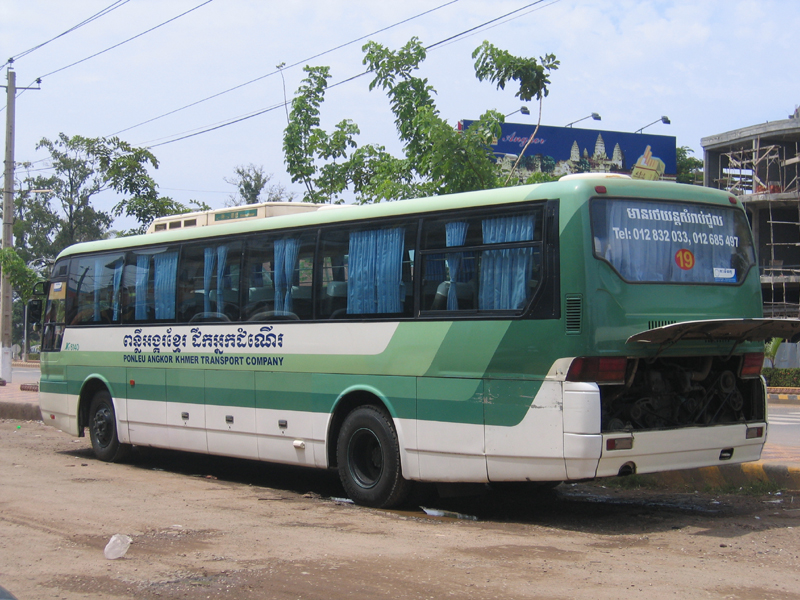 Phnom Penh and Takeo province are linked by the National Highway No 2, which remains in reasonable condition with a few potholes to slow the velocity down. Hour Lean and PPPT bus companies both run air-con buses between Phnom Penh and Takeo (6000riel, 2hours, 77km). They leave from the Central Station just southwest from the Central Market in PP. Leaving of to PP from Takeo you may find the buses in front of the Phsar Leu. Both buses have to pass Tonl? Bati and Phnom Chisor, both interesting sides of attraction.
Phnom Penh and Takeo province are linked by the National Highway No 2, which remains in reasonable condition with a few potholes to slow the velocity down. Hour Lean and PPPT bus companies both run air-con buses between Phnom Penh and Takeo (6000riel, 2hours, 77km). They leave from the Central Station just southwest from the Central Market in PP. Leaving of to PP from Takeo you may find the buses in front of the Phsar Leu. Both buses have to pass Tonl? Bati and Phnom Chisor, both interesting sides of attraction.
The price from PP by share taxi is around 6000riel, by minibus around 3000riel. Travellers continuing by road to Kampot should take a moto (5000riel) for the 13km journey Angk Tasaom and then arrange a seat in a minibus or share taxi (5000riel) on to Kampot. For 1000 riel you can get anywhere in town. The daily rate is US$ 5 plus fuel for distant sights.
Phnom Penh and Takeo province are linked by the National Highway No 2, which remains in reasonable condition with a few potholes to slow the velocity down. This is a maximum 2 hours ride for merit skilled motorbikers. If your motorcycle has a mechanic problem, head back to Phnom Penh, as it's only an hour away. Call your rental outfit in Phnom Penh (always carry theft rental agreement) and they will come down to perform motorcycle surgery or haul the bike back to Phnom Penh.
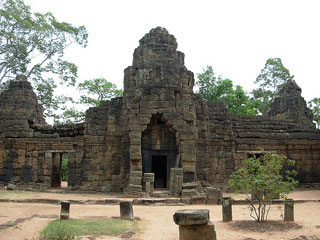 Chruos Phaork, Takeo is one of the well known nature and wildlife preserves in Cambodia. This serene and beautiful preserve is situated in the Pou Village in Preah Bat Choan Chum Commune. Chruos Phaork, Takeo is in fact located in the Kiri ong District which, in general, boasts of grand sceneries and lovely foliage.
Chruos Phaork, Takeo is one of the well known nature and wildlife preserves in Cambodia. This serene and beautiful preserve is situated in the Pou Village in Preah Bat Choan Chum Commune. Chruos Phaork, Takeo is in fact located in the Kiri ong District which, in general, boasts of grand sceneries and lovely foliage.
From the Provincial town the Chruos Phaork, Takeo is about 44 kms. Tourists will find sufficient conveyance and the journey is of a duration of 1 hour approximately. In this nature and wildlife preserve the tourists will get too see a lot of greenery. The flowers here are vibrant and colorful. Sometimes the tourists will find rare plants in the locale. It is indeed a delightful venture. Like most of the other natural and wildlife tourist attractions in Takeo at the Chruos Phaork too the tourists will find rare insects and birds too.
Chruos Phaork, Takeo is the perfect example of a well balanced bio-diversity. Flora and fauna live here in a kind of symbiosis. The tourists who have been to Chruos Phaork in Takeo love to come back and those who have not undertaken the journey should do so. If you are in Takeo then you cannot afford to miss the Chruos Phaork.
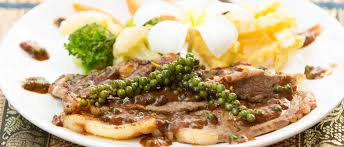 There are a couple of decent Khmer food restaurants near the waterfront, after the canal that heads to Vietnam, Angkor Borei and Phnom Da. You may also find plenty of cookeries in the area around the Independence Monument. By night this is the place to snack on Cambodian desserts or enjoy a ?tukalok? (fruitshake). And as for the night scene, there just isn?t much going on in Takeo town ? your best bet is to take it easy and remember that Phnom Penh is only an hour away.
There are a couple of decent Khmer food restaurants near the waterfront, after the canal that heads to Vietnam, Angkor Borei and Phnom Da. You may also find plenty of cookeries in the area around the Independence Monument. By night this is the place to snack on Cambodian desserts or enjoy a ?tukalok? (fruitshake). And as for the night scene, there just isn?t much going on in Takeo town ? your best bet is to take it easy and remember that Phnom Penh is only an hour away.
Located near Psar Nat, this restaurant is popular for their western delights which include pizza,pasta and burger. If you need something refreshing to quench your thirst, try their freshly home-made milkshake or juice. A good dining place not to be missed when you are in Takeo.
Mondays - Sundays 6am to 8pm. Contact: (855) 32 4540 345
This is an alternative spot for a good Cambodian meal during the dry season, when this part of the town is less stinky than the area near the water. It has an English menu and some tasty soups are a worth a recommendation.
This place is built on stilts, as the whole area becomes a giant lake during the wet season. The restaurant overlooks the canal to Angkor Borei, and it's one of the most popular lunch stops in town. It's a good place to tuck into some Khmer food before making a trip to Angkor Borei and Phnom Da.
This place is one of the first restaurants that you encounter as you enter Takeo from Phnom Penh. It's a friendly simple place, which feature rather decent Khmer and Chinese food.
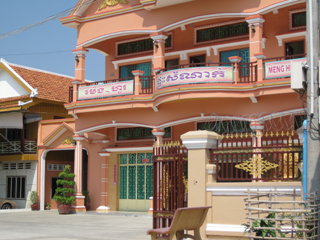 There are some reasonable options to get your head on a bed in Takeo, although the proximity of Phnom Penh means that few travellers actually spend a night here. Backpacker options could also be found at the empty Phsar Nat (also overlooking).
There are some reasonable options to get your head on a bed in Takeo, although the proximity of Phnom Penh means that few travellers actually spend a night here. Backpacker options could also be found at the empty Phsar Nat (also overlooking).
This hotel might be an option for those who have a particular attraction to Cambodian Independence Monuments, as this one overlooks Takeo's. There is good cheap food nearby, a fortune. Don?t be put of by the old house at the front, s the owners have added a new wing in a leafy green garden at the back, with the smartest air-con rooms in town. Prices range from $5-10.
That's a friendly family-run place, which has a bewildering array of rooms available and all at the same price. Some of them are bigger, some are smaller, some have TV and air-con, some don't, but in the interest of equality everyone pays the same. Have a look before, than choose.
This is likely the best place in town, overlooking the lake. All rooms are essentially the same (bath, fan, TV), but for $10 you can get an air-con breeze. Ask for a room with a view, as it won?t be more expensive. Prices from $5-10.
This guesthouse is right next door to the Angkor Borei and offers more or less the same array and equipment as the Ankor Borei, but is a little less in the price. Some rooms have only one bed, check it out before. Some of the staffs speak good English
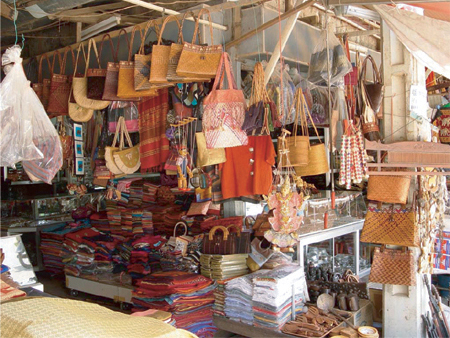 Takeo province is often referred to as the cradle of Cambodian civilisation Takeo province has several important pre-Angkorian sites built between the 5th and the 8th century. The provincial capital, Takeo town is an easygoing place that possesses a fair amount of natural and manmade beauty. The natural beauty is in the Scenic River and lake area that faces a pleasant town parkway. The low-lying area seems to include much of the surrounding province area, which is probably why a kingdom that once had its heart here was referred to as Water Chenla. There seems to be water everywhere in the surrounding countryside during the rainy season. The man-made beauty mostly comes from a series of canals and waterways that were cut through the surrounding countryside, many a very long time ago, connecting towns, villages, rivers and Vietnam. Nearby Angkor Borei town (connected by water to Takeo town) may have been the heart of the Funan Empire, which is called the Cradle of Khmer Civilization by Cambodians. Much older than Angkor, the Funan empire had its heyday between the 1st and 6th centuries and stretched across a vast area, from South Vietnam through Thailand, down through Malaysia and into Indonesia. Bold, silver and silks were traded in abundance in the kingdom, or, as some say, the series of fiefdoms.
Takeo province is often referred to as the cradle of Cambodian civilisation Takeo province has several important pre-Angkorian sites built between the 5th and the 8th century. The provincial capital, Takeo town is an easygoing place that possesses a fair amount of natural and manmade beauty. The natural beauty is in the Scenic River and lake area that faces a pleasant town parkway. The low-lying area seems to include much of the surrounding province area, which is probably why a kingdom that once had its heart here was referred to as Water Chenla. There seems to be water everywhere in the surrounding countryside during the rainy season. The man-made beauty mostly comes from a series of canals and waterways that were cut through the surrounding countryside, many a very long time ago, connecting towns, villages, rivers and Vietnam. Nearby Angkor Borei town (connected by water to Takeo town) may have been the heart of the Funan Empire, which is called the Cradle of Khmer Civilization by Cambodians. Much older than Angkor, the Funan empire had its heyday between the 1st and 6th centuries and stretched across a vast area, from South Vietnam through Thailand, down through Malaysia and into Indonesia. Bold, silver and silks were traded in abundance in the kingdom, or, as some say, the series of fiefdoms.
As it is quite common in Cambodia even small cities, such as Takeo have at least one bigger market (some small marts too). So you may also find a market in Takeo centre, which is a busy area with local shops dealing the local daily consumer products, like fish, fruits, vegetables, meats and packed products (also a lot from Vietnam). Most of the food and drink shops are surrounding the market.
.jpg)
